Messages
Leadership Dialogue Series: Interview with Professor Lars French, President of ILDS (2/4)
When you first attended, did you ever imagine that you would one day become the president of ILDS?
 No, I never planned that far ahead. As a clinician-scientist, I spend about 50% of my time seeing patients, and from the beginning I wanted to also do research, innovate and publish in high-impact journals. I wanted to better understand disease pathogenesis, hoping to bring new modalities for the treatment of patients. It is a huge challenge doing this in parallel with clinical work, but I also get many ideas for research by seeing patients in difficult situations where we do not have suitable treatments yet.
No, I never planned that far ahead. As a clinician-scientist, I spend about 50% of my time seeing patients, and from the beginning I wanted to also do research, innovate and publish in high-impact journals. I wanted to better understand disease pathogenesis, hoping to bring new modalities for the treatment of patients. It is a huge challenge doing this in parallel with clinical work, but I also get many ideas for research by seeing patients in difficult situations where we do not have suitable treatments yet.
This includes, for example, diseases like pyoderma gangrenosum, where there are no good diagnostic criteria. We are working on that now with transcriptomics, seeing if we can do better than clinicians and histology for diagnosis. I love tackling new challenges like this. Over time, I started becoming more active in Societies and realized their importance, both on national and international levels.
 Since your appointment three years ago, what has been the major challenge, and what do you enjoy about being the ILDS President?
Since your appointment three years ago, what has been the major challenge, and what do you enjoy about being the ILDS President?
The major challenge is making a difference for dermatology on the global stage. We do this through representation of, and engagement with, our members. One way is through the World Skin Summit, which brings together executives of member societies worldwide, to better understand problems in various regions. The next summit will be held from 11-15 October 2022 in Lima, Peru. A key outcome from the World Skin Summit has been our efforts to create better education-sharing worldwide, through launching GPEC.
Another big challenge is the seven fields in which we collaborate with the WHO. Regarding neglected tropical diseases, Rod Hay and Claire Fuller have been very helpful in providing educational material for field workers to diagnose skin diseases like Madura’s foot (Eumycetoma) or the cause of skin ulcers in African populations without dermatologists. We provide easy-to-understand educational material to field workers that helps them manage patients, or guide them to expert centers.
 We work hard to represent dermatology better in the field of noncommunicable diseases. The Global Psoriasis Atlas, which you can find online, is a living atlas reporting the burden of psoriasis worldwide. The Global Psoriasis Atlas was developed following the WHO Global Report on Psoriasis. Work is ongoing to help solve widespread problems of access to care. We are also actively trying to bring important dermatology medicines, such as the first biological therapy for moderate to severe Psoriasis vulgaris, onto the Essential Medicines List.
We work hard to represent dermatology better in the field of noncommunicable diseases. The Global Psoriasis Atlas, which you can find online, is a living atlas reporting the burden of psoriasis worldwide. The Global Psoriasis Atlas was developed following the WHO Global Report on Psoriasis. Work is ongoing to help solve widespread problems of access to care. We are also actively trying to bring important dermatology medicines, such as the first biological therapy for moderate to severe Psoriasis vulgaris, onto the Essential Medicines List.
In the ICD-11, we have managed to implement coding of occupational skin cancer so as to get better global reporting on its burden and the prevalence, which is underestimated. We work with our 20 ILDS board members, but also with external experts, to help move such projects forward and have deliverables.

